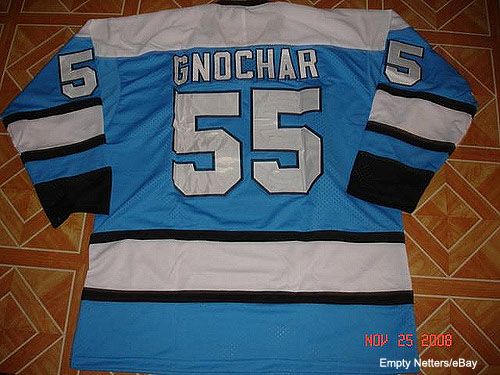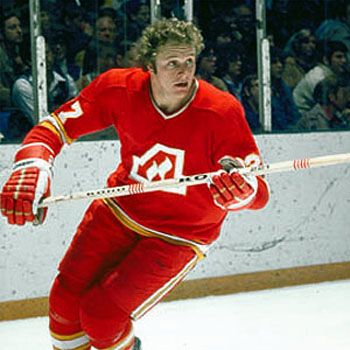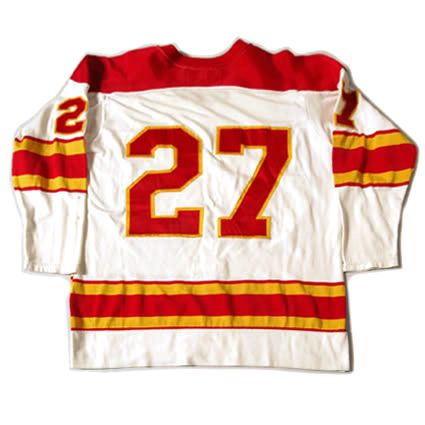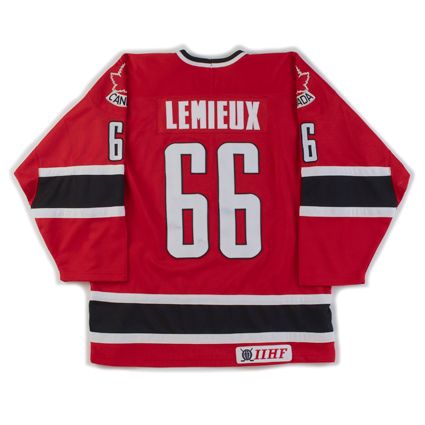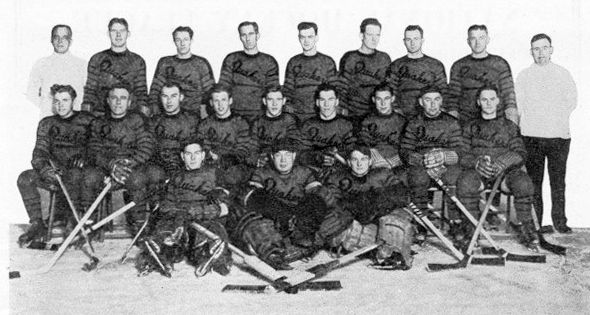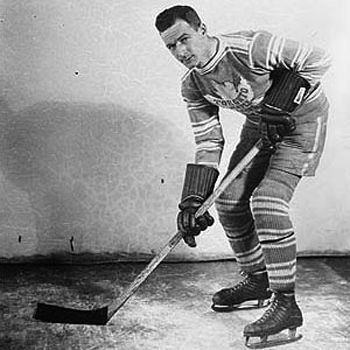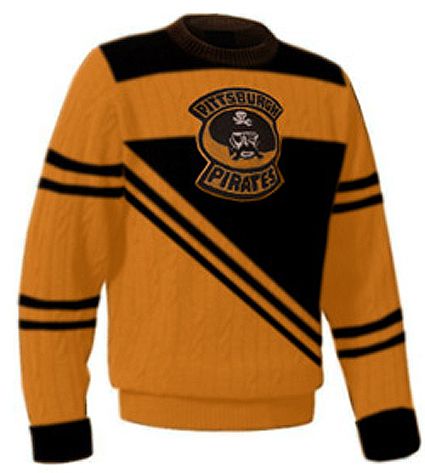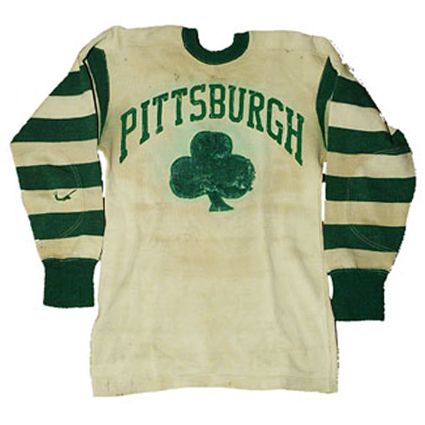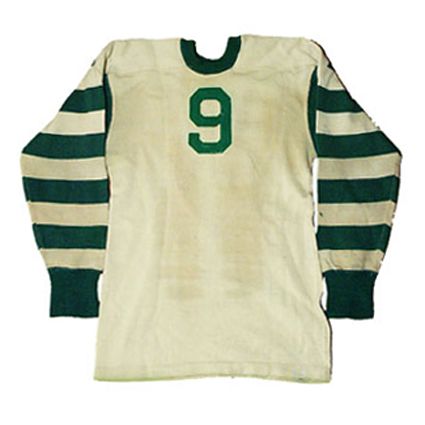Saturday, September 18, 2010
Hockey Jersey Training Camp - Day 2 - Where to Buy Your Jerseys
Day 2 of Hockey Jersey Training Camp brings us to our next "drill", where to buy your jerseys.
In the pre-internet past, buying jerseys was limited to the souvenir stand of your local team and a few select options at a limited number of sporting goods stores.
With the arrival of the internet into our homes, the options for the jersey collector have expanded exponentially since the mid 1990's, beginning with any number of online retailers and of course, ebay, the world's biggest garage sale, where collectors across North America could buy and sell their jerseys without regional boundaries and limited selections as in the past.
Other options beyond ebay that began to appear were online stores, such as IceJerseys.com, RiverCitySports.com, United States College Hockey Online's internet store (USCHO.com) and Shop.NHL.com, who focus almost exclusively on hockey, as well hockey equipment dealers like HockeyGiant.com, HockeyMonkey.com and TotalHockey.com, who all have a jersey selection as part of their hockey gear websites as well as other broader appeal sporting goods retailers such as FogDog.com and FansEdge.com.
No mention of online jersey sellers would be complete without a mention of the wonderfully unique WorldHockeyJerseys.com, who deal with mainly national team jerseys of quite nearly 50 different countries and have been responsible for some real gems in our collection, such as national team jerseys from Estonia, Iceland, the Netherlands and Poland since their founding in late 2006. It was absolutely unheard of to be able to purchase a Mongolian National Team jersey on demand until WHJ came on the scene!
If you are looking for some really obscure or unique items, go no farther than VintageMinnesotaHockey.com. The selection offered by VMH is like no other, beginning with a 1915-16 St. Paul Athletic Club jersey and moving through the history of Minnesota hockey through classic high school, junior, college, minor league, WHA and NHL Minnesota classics, all produced with painstaking detail and quality. Where else are you going to be able to purchase Neal Broten's high school jersey? And if you are a fan of the University of Minnesota, or the players they have recently sent to the NHL, VMH is the place for you to get your Gophers jerseys, from 1936 to 2008.
Another "garage sale" approach online can be your local Craigslist.org listings, where the occasional gem can be found.
Unfortunately the main source we have relied on for over a decade, ebay, has taken an enormous turn for the worse, as fees associated with selling on ebay have risen again and again and again, which are naturally passed on to the buyer whenever possible. Rising postage costs have also made ebay less attractive to a certain degree, but the main problem with buying on ebay these days is the incredible proliferation of fake jerseys from China flooding the market and making the legitimate jerseys quite difficult and time consuming to locate and identify among all the static.
A poor quality knockoff jersey with "Gonchar" misspelled!
Sadly, ebay has little reason or incentive to attempt to curtail all the illegal activity crowding out the legitimate jerseys as they profit from each and every one of the thousands of the knockoffs listed on their site through the listing fees they charge, whether an item sells or not.
Should any of these jerseys actually sell to those unknowingly thinking they are getting a great deal or don't care that the jersey is a fake when compared to the price of a real jersey, ebay makes even more money on both the final value fee and the subsequent paypal payment, further reducing their incentive to clean up their listings, as turning a blind eye to the fake jerseys only helps their bottom line.
Still, despite it's problems, ebay is still the place to look for the majority of what you want as long as you are able to identify the real jerseys from the counterfeits, especially if you are interested in any of the older style jerseys prior to the arrival of Reebok becoming the supplier to the NHL in 2007-08, as the above listed online shops only carry the current seasons jerseys almost without exception.
If one thinks ebay has gotten bad, it hardly compares to the cesspool of junk peddled on craigslist. Even finding a legit jersey for sale with adequate photos is like finding a needle in a haystack, but it can be done with some persistence and luck.
Another alternative to paying retail prices at the various online stores or dealing with the hassles of ebay is to buy directly from other collectors. A limited number of online forums, such as that hosted by IceJerseys, Jersey Central.org or the game worn forums at both GameWorn.net and GameWornJerseys.com all have marketplace sections where collectors can buy from and sell to other members of their online community.
After you have been a member of these discussion forums for a period of time, you will learn which members are trustworthy and have established reputations as honest people to deal with. We personally have started to buy an increasing percentage of our jerseys directly from others this way.
Some of those forums have rules which require you to be a member for a period of time and also participate as an active member of the forum with a minimum number of posts before you can sell your jerseys there. Please be respectful and follow not only their established guidelines, but the spirit of those guidelines. Creating a two dozen brief posts all in one day which add nothing to the conversation and annoyingly dredge up old threads to simply meet the number of posts required will not fool anyone will harm your reputation as a trustworthy seller and won't earn you selling privileges anyway.
If you have any other favorite sources to obtain your jerseys, we'd love to hear about it in the comments section below.
We also invite you to visit the selected advertisers mentioned above in our ThirdStringGoalie marketplace sections in our right hand column of this page.
Labels:
Hockey Jersey Training Camp
Friday, September 17, 2010
Hockey Jersey Training Camp - Day 1 - What to Collect
Welcome to Hockey Jersey Training Camp! We are going to cover a number of topics over the course of HJTC in an effort to aid the collector of jerseys, both veteran and rookie.
Our first "drill" will focus on what to collect.
Many fans just buy a jersey or two from their hometown team and call it a day until the player whose name is on the back of their jersey leaves the team, especially under less than friendly circumstances. They are then faced with the choice of wearing a newly outdated jersey, buying a new jersey or simply going to the games with a team sweatshirt.
The true jersey collector does have to worry about such things, as they have any number of jerseys to fall back on in the event a star player leaves their team.
Many collectors simply buy what catches their eye, regardless of what team it's from, or at least to some degree, as some passionate fans cannot overcome their hatred of their favorite team's rival to ever own one from the enemy. Other collectors develop a theme to their collections, and that's what we are going to focus on today.
The most common theme is to buy jerseys from your favorite team, be it an NHL club, or their local minor league affiliate,l junior or college team. For example, some collectors will only purchase Avalanche jerseys. Others Avalanche fans will branch out to include such things as jerseys of Avalanche players from appearances in All-Star games and various international tournaments, such as a Joe Sakic 2000 All-Star jersey or a Peter Forsberg Sweden National Team jersey, in both an effort to wear something a little different from the masses and demonstrating the increased depth of their hockey knowledge, like this amazing Colorado Avalanche collection. One way to add interest to the single team approach is to add jerseys with additional anniversary, all-star or memorial patches a club may have worn.
Other fans will focus their collection not on a single team, but a single player, with Wayne Gretzky or Mario Lemeiux being prime examples, as both players not only wore a number of NHL jerseys, with Gretzky having played for four different teams, while Lemeiux wore no less than eight different Penguins styles, 11 different All-Star jerseys and skated for Canada in five international tournaments.
Other star players often lend themselves to this approach, such as Sakic, Teemu Selanne or Jaromir Jagr to name a few, with the multiple options for NHL, All-Star and International jerseys they have worn during their careers. Sydney Crosby and Alexander Ovechkin lend themselves to this approach for those of you just getting started in collecting given the opportunity you will have to buy their jerseys when they are current, rather than trying to find discontinued styles that are long out of production from older players, although you better get started, as Ovechkin has already played for Moscow Dynamo, who changed jerseys every one of his four seasons there, the Washington Capitals, who have already changed jersey styles during his five seasons with the club, in three NHL All-Star games and the Russian National Team nine of the last ten years!
Some fans in smaller locales have been known to collect the NHL jerseys of former players on their local minor league team who have gone on to play at the highest level. This can lead to some unusual and off-beat player choices, as obvious star players are passed over for journeymen types with short careers due to their local connections to the collector.
Other player oriented themes are Hall of Fame players, black players, rookie jerseys and goalie collections.
Getting away from the focus on individual players, some try to collect at least one jersey from each NHL club, defunct clubs, All-Star Game jerseys, each year's Stanley Cup champion or even each year's Conn Smythe winner. One other theme is to collect jerseys from a particular season, our favorite of which is the 1991-92 NHL season, which saw the Original 6 teams all wearing Turn Back the Clock jerseys and all players wearing the attractive NHL 75th Anniversary logo that season.
Adding the unique jerseys worn each year in the now annual Winter Classic is also a good way to add some unique jerseys to one's collection without a huge financial outlay each season, although it appears that there will now be a pair of outdoor games each season going forward to generate more specialty jerseys for you to pursue.
There is also a subset of collectors who focus on the rare, unusual and unloved jersey styles, such as the short-lived alternate jerseys like the Mighty Ducks "Wild Wing" or Los Angeles Kings "Burger King" jerseys. The New York Islanders Fisherman era sweaters and the Tampa Bay Lightning "Stormy Weather" alternates are also quite popular with fans of what we like to call the "Curious, Weird and Ugly" jerseys. Of those, the Kings alternate is the perfect storm of collectability, being scarce due to it's short life, desirable due to it's unattractiveness and the added competition to own one from those who focus on Gretzky jerseys.
Still other themes consist of either the jerseys of your home country, such as the various Team Canada or Team USA jerseys, and one ambitious collector has taken the opposite approach by attempting to collect jerseys from as many different national teams as possible, which can be quite a challenge given the over 50 full member countries in the International Ice Hockey Federation, which include lesser-known hockey playing nations as Australia, North Korea, Mexico, New Zealand and South Africa!
There's also jerseys from your favorite minor, junior or college teams that can be the basis of a collection.
Once you decide if your collecting is going to have a loose or rigid theme, then there is the aspect of buying only authentic jerseys, the kind with fightstraps which are the same as those worn by players on the ice, or if replica jerseys fit your taste and budget, as throughout the 1990's replica jerseys were made to a very high standard by CCM, Nike, ProPlayer and Starter.
And so far we have not even mentioned the aspect of focusing on game worn jerseys, which is a whole culture in and of itself, as collectors try to track down the actual jerseys worn by the players on the ice during the games. As with anything, there are options in game worn collecting to fit most every budget, as lesser known players or even pre-season jerseys can sometimes be had for prices occasionally below a retail authentic.
Pick one concept or multiple themes if you wish, but be careful to not pick them all, or you just might find yourself writing a daily blog about your collection!
Have an unusual theme for your collection not mentioned here? Please post it in the comments below, as we'd like to hear what interesting ideas others have come up with.
Our video section today features some collectors who have chosen to share their collections on youtube.
Labels:
Hockey Jersey Training Camp
Thursday, September 16, 2010
1974-75 Atlanta Flames Eric Vail Jersey
Eric Vail, born on this date in 1953, was drafted 21st overall in the 1973 NHL Amateur Draft by the Atlanta Flames following his junior career, which began with the Niagara Falls Flyers of the Ontario Hockey League. After scoring 48, then 73 points in 60 games Vail split time between the Sault Ste. Marie Greyhounds and the Sudbury Wolves for the 1972-73 season and caught the eye of the Flames scouts with a 48 goals and 105 points in 63 games. He also averaged 101 penalty minutes his last two seasons in junior hockey, showing a rugged side as well.
He started the 1973-74 season with the Omaha Knights of the Central Hockey League, and after 37 games was called up to the Flames for 23 games that season.
His first full season in Atlanta saw him establish himself as a valued member of the Flames by placing third in team scoring behind only Tom Lysiak and Curt Bennett while leading the team in goals with 39 on his way to being named the winner of that season's Calder Trophy.
He rebounded from a sophomore slump in 1975-76, in which he scored only 16 goals, with a strong 1976-77 campaign in which he scored 32 goals and 71 points to place second on the team in both categories. His efforts earned him a chance to play in both the NHL All-Star Game and join Team Canada for the World Championships following the NHL season.
He again topped 20 goals two seasons later in 1978-79 with 35 goals and a career best 83 points. Following one more season in Atlanta, the Flames found themselves in financial difficulties due to their annual habit of being quickly eliminated from the playoffs, thanks to five consecutive preliminary losses and two seasons out of the playoffs in eight years, and the cost of competing for players with the World Hockey Association, which dramatically increased player salaries during the 1970's. The club was sold to new ownership who promptly relocated the franchise to Calgary.
After a productive 1980-81 season in Calgary, where Vail averaged a point a game, he began the 1981-82 season with the Flames but was traded after playing in only 6 games to the Detroit Red Wings where he would see action in 52 games. He spent the final season of his career with the Adirondack Red Wings in the American Hockey League, but did not receive a call-up from Detroit and retired at the conclusion of the season.
Vail's final NHL totals were 591 games played with 216 goals and 260 assists for 476 points.
Today's featured jersey is a 1974-75 Atlanta Flames Eric Vail jersey. The Flames used the same jersey for each of their eight seasons in Atlanta and it remained intact after the relocation to Calgary, allowing for the obvious change in crest from the flaming A to the flaming C, all the way through the 1994-95 season, a 15 year run for this classic hockey template.
The Calgary Flames pay tribute to their past by using the original Atlanta Flames logo as the A worn to designate their alternate captains.
This jersey was worn without names on the back until 1977-78 when they became mandatory for all NHL jerseys.
Today's video hunt finds us with nothing but brawls to pick from, as the Flames apparently never actually scored any goals if we are to believe youtube.
Note the Philadelphia Flyers reverse nameplates. They had one set made up for TV games and wore them on both the white and orange jerseys, a look they have recently revived.
This next collection of mayhem features the Flames and the Maple Leafs from 1979.
Labels:
Atlanta Flames,
Vail Eric
Wednesday, September 15, 2010
1976 Team Canada Darryl Sittler Jersey
With Canada dissatisfied with the state of international hockey owing to the controversy over the amateur status of the Soviet players, the Canadians withdrew from both the World Championships and the Olympics from 1970 to 1977. Canada got what they wanted in 1972, with the wildly successful Summit Series, and eight game "friendly" competition between the best Canadian professionals versus the finest the Soviet Union had to offer. As the tournament progressed, the Soviets, looking like they would finish with a better record declared their intentions to claim "victory" in the series only to have the Canadians come out on top with a dramatic late goal in the final game of the series.
Following the 1974 Summit Series which featured a team of WHA All-Stars who were soundly defeated by the Soviets, an attempt to catch lightning in a bottle once more led to the formation of the 1976 Canada Cup tournament.
The tournament was expanded beyond the two-team competition of the Summit Series format to include not only Canada and the Soviets, but Czechoslovakia, Finland, Sweden and the United States, with each team playing the other five clubs in a round robin format with the top two then meeting in a best-of-three final.
The games were played in Ottawa, Toronto, Montreal, Winnipeg and Quebec in Canada and Philadelphia in the United States and would be held prior to the NHL season, removing any conflicts for players, such as those faced by the Olympics and World Championships, making the all the top players available to compete.
The Canadian team was also given top priority in Canada, as the restrictions the roster faced due to the NHL/WHA rivalry that affected both the 1972 and 1974 Summit Series were removed.
While many hoped for and anticipated a Canada vs. Soviet Union final, the Soviets did not field their best possible team, leaving several key players at home, including Boris Mikhailov, Vladimir Petrov, Alexander Yakushev and Valdimir Shadrin for reasons subject to speculation, but thought to be a combination of a power struggle between the Soviet Canada Cup coach and the Soviet Olympic Team coach, as well as a desire to downplay the importance of the new tournament, claiming their focus was on the World Championships and the Olympics, where they knew they would have the advantage of a full roster, while Canada would have the majority of it's professionals occupied with the Stanley Cup playoffs during the World Championships or unavailable during the Olympics. The Soviets were also most notably without Valeri Kharlamov, who was out due to injuries suffered in an auto accident.
Canada opened with a strong statement, as they blitzed Finland 11-2. The following day. September 3rd, the Czechs beat the Soviet Union 5-3. Two days later the Soviets had to settle for a 3-3 draw with Sweden and the Czechs hammered Finland 8-0 while the Canadians got past the USA 4-2.
On September 7th, the Soviets took their turn pummeling Finland 11-3 as the USA held the Czechs to a 4-4 draw and Canada stayed undefeated with a 4-0 win over Sweden.
The Soviet Union stayed alive with a 5-0 win over the USA and the Czechs claimed the top spot in the standings with a close-fought 1-0 triumph over Canada.
On September 11th, Sweden gave the Soviets hope by narrowly edging Sweden 2-1 but they were eliminated from a berth in the finals when Canada got the satisfaction of ending their arch-rivals tournament with a 3-1 win over the Soviet Union, setting up a Canada - Czechoslovakia final.
The finals kicked off with a game in Toronto on September 13th, with Canada making it clear they were out to set the record straight as to who was the best hockey nation with a 6-0 pounding of the Czechs. Gilbert Perrault, scored just 1:05 into the game to give Canada an early lead, and their first goal against the Czechs after being shut out by them in their round robin matchup. Denis Potvin increased the lead to 2-0 at 7:56 and Bobby Orr made it 3-0 on the powerplay at 13:34. Guy Lafleur added another at 17:01 to give Canada a dominant 4-0 lead before the first period was even over.
There were no goals in the second and Canada added a pair in the third, with Orr scoring again at 11:35 and Darryl Sittler just before the final whistle at 19:56 for a final six goal margin as Rogie Vachon recorded the shutout for Canada.
The second game of the finals was held in Monteal on this date in 1976 and started out very much the same as Game 1, with Canada up by two after only three minutes, as Perreault scored early once more at 1:25, followed by Phil Esposito at 3:09.
The Czechs would respond this time though, with a goal in the second at 9:44 from Milan Novy.
The dramatic third period would see five goals, with the first coming at 2:14 as the Czechs evened the score at two when Jaroslav Pouzar scored. Bobby Clarke would give Canada the lead at 7:48, only to have Josef Augusta tie the game once more at 15:01.
The Czechs would then surprise the Canadians by taking the lead for the first time when future NHLer Marian Stastny scored less than a minute later at 16:00. Canada would force overtime when Bill Barber even the game at 4-4 with a goal at 17:48.
As the game moved into overtime Canada put two pucks into the Czech net, only to have them both disallowed. The first was on a shot by Lafleur, which got by the Czech netminder Vladimir Druzilla, only to have Ivan Hlinka knock the net off it's pegs before the puck could cross the line, earning a penalty, but no goal.
Guy Lapointe then scored at the ten minute mark, but the rules stated that the teams had to change ends halfway through the period, so the horn sounded, negating Lapointe's goal, much to the dismay of the Canadians and their fans.
Finally at 11:33 of the overtime, the clock struck midnight for the Czechs, as Sittler deked Druzilla, who had a habit of some very unorthodox play (no doubt influencing a young Dominik Hasek) which included coming way out of his net, and scored the game winner, (finally) giving the Canadians the championship to thrill the home fan in what was the most watched program in Canadian TV history at the time.
"This has got to be the biggest thrill of my life," Sittler said. "I'm not cut out to be a hero; if I was going to do it, I was going to do it. But playing with these guys on the greatest team for the greatest country is something that will remain with me forever."
Orr, who missed the 1972 Summit Series due to one of his many knee surgeries, was able to play in 1976 following his fifth knee operation. "It was Bobby's last hurrah," said Esposito. "Orr didn't show up the first week of training camp because of his knee problems, and we had some pretty imposing defensemen there. But when he arrived it was the man with the boys. He was just head and shoulders above the rest of us," said Bobby Hull.
Clarke said "I used to watch him. After the games he could hardly walk, and then he'd go out there again and play like hell. I think he played on straight determination. It's amazing what he did."
Orr finished the tournament with 2 goals and 7 assists for 9 points, tied for most in the tournament with fellow Canadian Potvin and Soviet Viktor Zhulktov, and was named Tournament MVP. Orr's performance in the 1976 Canada Cup would be ranked as #56 in the IIHF Top 100 Stories of the Century.
Of note, 16 of the 21 Canadian players would eventually be inducted into the Hockey Hall of Fame.
Today's featured jersey is a 1976 Canada Cup Darryl Sittler jersey. This unique jersey would make it's debut at the 1976 Canada Cup, with it's main design patterned after the Canada Cup trophy. This style would become an icon for Canadian hockey, as it was also used in the four subsequent Canada Cups in 1981, 1984, 1987 and 1991, something the marketing people would never allow to happen these days.
This style was revived once more, as it was the choice for the Canadian team in the 2005 World Championships when each country chose a throwback jersey from it's past.
The Canadian players participated in the ritual of exchanging jerseys after the game, a practice more commonly associated with European soccer, no doubt creating quite a challenge for collectors of game worn jerseys to locate and authenticate the set of jerseys worn in the final game after their departure for behind the Iron Curtain.
Today's video section features Sittler's cup winning goal in overtime of Game 2 of the finals.
Here is a tribute video to Team Canada with action highlights from throughout the tournament, with perhaps the cheesiest song ever written.
Enjoy these exciting highlights of the Canada vs. Soviet Union game from the round robin stage of the tournament with Tretiak in goal for the Soviets.
Labels:
1976 Canada Cup,
Canada,
Sittler Darryl
Tuesday, September 14, 2010
2004 Team Canada Mario Lemieux Jersey
On this date in 2004, Canada captured the World Cup of Hockey Championship with a 3-2 win over Finland in front of 19,370 fans at the Air Canada Centre in Toronto.
Canada began the tournament in the North American pool with a 2-1 over the United States in Montreal while wearing their 1920 Winnipeg Falcons throwback jerseys.
They came back the very next night, again in Montreal, with a strong performance in a 5-1 throttling of Slovakia thanks to a pair of goals from Ryan Smyth.
Canada captured the group on September 4th when they beat Russia 3-1, this time in Toronto to finish pool play undefeated.
With the top North American seed drawing the fourth place North American finisher, Canada was once again matched up with the Slovaks on September 8th in Toronto with similar results to their first meeting, as Canada again scored five times in a shutout victory to advance to the semifinals.
Their opponent would be the Czech Republic, the number 3 European Pool seed, surprising 6-1 quarterfinal winners over Sweden. In perhaps the best game of the tournament, Canada scored twice in the second period after a scoreless first before the Czechs got on the board before the end of the period. Seven minutes into the third the Czechs evened the score at 2-2. Canada got the go ahead goal at 13:47 only to have the Czechs shock the still celebrating arena with an equalizer a mere six seconds later.
Vincent Lecavalier then won it for Canada with a goal at 3:45 into overtime to send Canada to the finals.
In the Final, the Canadians and the Finns traded goals in the first period before Canada went up by one with a goal three minutes into period number two. The Finns scored a late goal at 19:00 of the second to send the tournament into it's final 20 minutes all even.
It would only take 34 seconds for Canada's to score on assists from Joe Thornton and Adam Foote to return Canada to the lead for the third time in the game. The Canadians would make that goal stand as Martin Brodeur would hold off Finland with ten saves to secure the championship for Canada.
Lecavalier would lead Canada in scoring with 2 goals and 5 assists for 7 points in 6 games to earn tournament MVP honors. Broduer was named the goaltender of the tournament's All-Star Team following his goals against average of 1.00 in five games and a .961 save percentage. Foote would join his fellow Canadians on the All-Star Team at defense.
Today's featured jersey is a 2004 Team Canada Mario Lemieux jersey. Canada debuted this jersey style at the 2002 Salt Lake Olympics and it proved a very worthy look for an unprecedented era of Canadian dominance in international hockey, as both the Canadian men and women would win gold medals in 2002, the men would win the World Championships in 2003 and 2004, the women would capture the 2004 World Championship and the men's U-20 team would cruise to the World Junior Championship in dominant fashion in 2005 giving Canada the titles in all six major championships at the same time, all won in this style jersey.
Canada would later celebrate their lofty status by altering the outline of the maple leaf logo on the jersey's crest from silver to gold to remind everyone of their unprecedented dominance over the hockey world.
Today's video highlights are of Canada's victory over Finland in the 2004 World Cup of Hockey finals in Toronto.
Monday, September 13, 2010
1929-30 Pittsburgh Pirates Harold Darragh Jersey
Born on this date in 1902, Harold Darragh first played four seasons in the Ottawa City Hockey League for the Ottawa Gunners prior to joining the Pittsburgh Yellowjackets of the United States Amateur Hockey Association in 1922-23
He returned to the OCHL with the Ottawa New Edinburghs for the 1923-24 season prior to returning to the Yellowjackets for 1924-25.
He remained in Pittsburgh for the following season, only this time with the Pittsburgh Pirates of the NHL. Darragh finished third in scoring while helping the Pirates finish third in the seven team NHL and were one of three clubs to make the playoffs.
Darragh would finish second in team scoring the following two seasons before tying for the team lead in scoring for the 1928-29 season, but with a mere 12 points in 43 games as the low-scoring Pirates would only total 46 goals in 44 games.
The Pirates suffered through a dismal 1929-30 season, as they would only win five of 44 games. Darrah however, benefitted greatly from a new rule change which permitted forward passing in the offensive zone for the first time, and set personal highs with 15 goals and 17 assists for 32 points in 42 games, nearly three times more than the previous season.
The Pirates were in financial difficulties and also in need of a new arena. With no solutions forthcoming in Pittsburgh, the team looked for greener pastures and relocated to Philadelphia where they were renamed the Quakers for the 1930-31 season.
The 1930-31 Philadelphia Quakers. Darragh is the third from the right in the back row.
After ten games with the Quakers, Darragh was traded to the Boston Bruins for the remainder of the season.
When the Bruins asked for waivers on Darragh, he was purchased by the Toronto Maple Leafs for the 1931-32 season, the same season the club moved into Maple Leaf Gardens. Toronto finished with the third best record during the regular season. During the playoffs, the Maple Leafs eliminated the Chicago Black Hawks in a two-game, total-goals playoff 6-2 and then did the same to the Montreal Maroons 4-3 to advance to the Stanley Cup Finals. There, the Maple Leafs swept the New York Rangers 5-4, 6-2 and 6-4 to earn Darragh the only Stanley Cup title of his career.
He would play 19 games the following season in Toronto before leaving the club and joining the Syracuse Stars of the International Hockey League to finish out the season. He also played the 1933-34 season with the Stars prior to taking a year off before returning to the ice with the Pittsburgh Shamrocks, also of the IHL for his final season as a player.
His final NHL totals were 308 games played, 68 goals and 49 assists for 117 points and a mere 50 penalty minutes, as Darragh was known as a very gentlemanly player. For the final 12 seasons as a player, Darragh only registered more than 6 penalty minutes in a season twice (16 in 1927-28 and 12 in 1933-34).
Today's featured jersey is a 1929-30 Pittsburgh Pirates Harold Darragh jersey. This unusual style jersey was worn for the Pirates last season in Pittsburgh and featured a change from black and yellow to black and orange. Those colors would be retained when the team relocated to Philadelphia for the Quakers only season and adopted by the expansion Philadelphia Flyers in 1967.
This jersey used simple one color block numbers on the back.
Having played in both Pittsburgh for their final season and with the Quakers during their only season, Darragh wore two of the rarest styles of jerseys in NHL history and we can only hope his family was lucky enough to have inherited them, as their value would be quite enormous these days.
Bonus jersey: Today's Bonus jersey is a 1935-36 Pittsburgh Shamrocks jersey. It's unusual to think of a jersey from Pittsburgh being colors other than black and gold these days, but this classic example of a 1930's jersey features barberpole striped sleeves and a plain body adorned with a vertically arched name and simple shamrock logo. The striped sleeves gives it an appearance more like a football jersey from the time period.
For more on the history of hockey in Pittsburgh, we recommend the excellent PittsburghHockey.net.
Our video section today features the history of hockey in Pittsburgh.
Labels:
Darragh Harold,
Pittsburgh Pirates
Subscribe to:
Comments (Atom)

